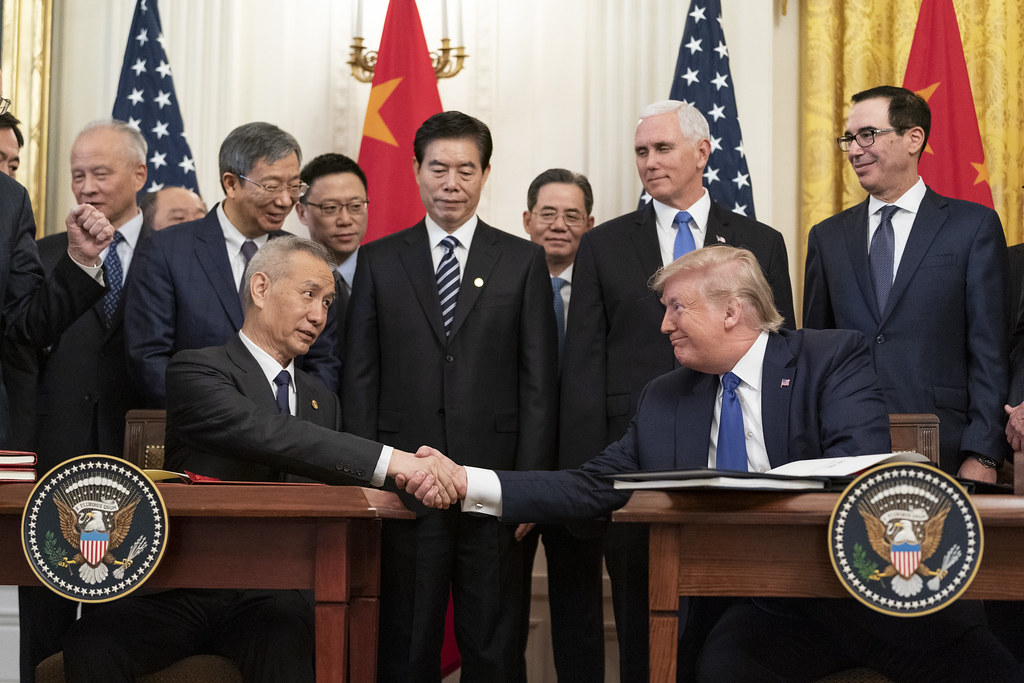Mapping the China Debate
To better understand the conversation on U.S. policy toward China, it’s helpful to break down hawks and doves into more precise categories.

Published by The Lawfare Institute
in Cooperation With

The debate over U.S. foreign policy toward China is often boiled down into the usual hawk-versus-dove metaphor. Hawks see U.S.-China great power competition as requiring a more aggressive posture, while doves worry about the downsides of an adversarial relationship.
But this dualist frame glosses over the fact that neither camp has a shared set of views. Rather, both hawks and doves contain a variety of subgroups—and some subgroups disagree with others on critical policy questions. But without tractable categories for analysis, the debate over policy toward China is too often imprecise and confusing.
To better understand the conversation on U.S. policy toward China, it’s helpful to outline the central perspectives with greater nuance. Of course, any attempt to do so isn’t going to be perfect. A given individual might have complex views that can’t be boiled down to a single set of concerns, or that could change from issue to issue. But mapping the different camps, even if the map is overly stylized, can help clarify the arguments in this debate, identify places where there are common or contrasting views, and suggest lines of inquiry or further probing where there are weaknesses in the arguments.
Categories in the Debate
There are at least ten categories in the debate: four on the dovish side, and six on the hawkish side. Let’s start with four categories of doves.
Neoliberal doves hold that global economic interdependence should proceed at the greatest possible clip, and economic restrictions limiting trade between states should be as narrow as possible. A few may still think China’s government will reform toward a more liberal market system, but most simply prefer global capitalism over other political goals. The challenge for neoliberal doves is that they do not take geoeconomic realities seriously enough: Economic power comes with geopolitical leverage, and the United States cannot ignore the power that China exercises.
Leverage doves, in contrast, recognize China’s rising power and the dangers it might bring. But they recommend that U.S. foreign policy pursue interdependence, rather than disentanglement between the two countries, in order to preserve American leverage over China. Leverage, they hope, will make conflict less likely. What the leverage argument too often ignores, however, is that China is moving swiftly to reduce its dependence on the United States, through a process of “indigenization”—that is, increasing domestic research, innovation, and production, especially in advanced technologies. As China becomes less dependent on the U.S., American leverage will invariably decline. The consequence might be a state of asymmetric dependence, in which the United States is reliant on China, but China isn’t reliant on the United States.
Transnational doves believe the biggest threats to the United States—like climate change—can be solved only through U.S. cooperation with other great powers. Any dangers of a rising China are far less problematic than the extinction-level challenge posed by climate change, they argue, and hawkish policies will make collaboration less likely. But it is not clear why rivals cannot cooperate on areas of shared self-interest, as even the U.S. and Soviet Union did during the Cold War; why China would cooperate if climate action is not in Beijing’s self-interest; or why climate activists shouldn’t prioritize a national U.S. industrial policy to massively expand domestic clean energy production, which could also be mobilized for export and simultaneously improve America’s global competitiveness.
Anti-war doves worry that hawkish language and policies might increase the risk of war. Like Graham Allison, they are anxious about Thucydides’s Trap: that fear in each country might spiral out of control and push the U.S. and China toward a military conflict neither country desires. Given that competition is largely over how much geoeconomic power each country has and, in particular, over primacy in areas of technology that are expected to drive the economy in the future, it is not clear why such heightened economic competition must invariably lead to conflict.
Turning to the hawkish side, there are six groups.
Liberal hawks are primarily worried about human rights. “Liberal,” of course, is a slippery term—here, I use it to refer to modern liberalism’s strong emphasis on individual rights, as people in this camp seek to prioritize and challenge China’s violations of human rights. But it is unclear how much of an impact liberal hawks can have: China’s use of technology for domestic social and political control, often called digital authoritarianism, coupled with its significant global power, makes this fight an uphill battle.
Nationalist hawks frame the China challenge through a racial lens, relying on xenophobic tropes to express their position. President Trump’s continued references to the “Chinese Virus,” for example, have sparked fear, hate and violence targeted at Asian Americans. Comparatively few in foreign policy circles seem to hold this view, though those who do have a prominent voice in the current administration.
Traditional hawks are worried about conventional political and military issues, but they attend little (or not at all) to economic power. They argue that the rise of neo-authoritarianism, including in China, is one of the central challenges facing the United States today—but they often push economic issues to the side. The difficulty, of course, is that it is not possible to hive off economics. There is simply no way to assess great power competition without it, and all the more so because China’s model doesn’t separate economics and politics; the state and the market are inextricably interconnected.
Leverage hawks, like their dovish counterparts, see the goal as having enough power and leverage to make China change practices like technology transfer and intellectual property theft. But unlike the doves, they don’t emphasize interconnectedness as their central strategy. Rather, they stress working with allies to develop a coalition that can put greater pressure on China to change its ways. Some might analogize to collective sanctions efforts; others might propose reforms to the World Trade Organization. The challenge for this group is that getting China to reform might not be possible, both because Chinese policies are deliberate and because China is actively working to make itself less vulnerable to pressure through indigenization.
Corporatist hawks take China’s rising economic power seriously and see geoeconomic competition as one of the central domains of the future. In a contest between the U.S. and China over technological innovation in artificial intelligence, robotics and quantum computing, corporatist hawks believe the best way forward is protecting Google, Apple, Facebook, Amazon and other American companies. But this “national champions” approach suffers from important logical and political problems: Many of these companies are not “competing against China,” they are operating in China; unregulated monopolists do not necessarily innovate as well as competitive markets, so protecting national champions could fail on its own terms; and economic power always becomes political power, so national champions are themselves a threat to representative democracy in America. The danger in corporatism is that the competition between China and the United States will become a contest between Chinese digital authoritarianism and American digital oligarchy—a government of tech magnates instead of we the people.
Resilience hawks also worry about China’s rising economic power and the dangers it poses—but they are equally worried about the inequality of wealth and power in America. They hold that America needs to disentangle itself from China, deepen engagement with allies to build countervailing power vis-à-vis China, and simultaneously pursue economic development at home. Their aim is not to change China but, rather, to develop resilience to defend democracy in America and like-minded countries. Rather than rely on national champions, they focus on public investment in research and development, infrastructure, competition policy, antitrust and regulation, along with industrial policies designed for broad-based growth. The central problem for resilience hawks is that many of the policies necessary to ensure a resilient democracy, social infrastructure and economy run directly counter to the interests and political preferences of those who have power and influence in American politics (on both sides of the aisle), making implementation difficult.
Arguments and Perspectives in the Debate on China
Mapping these subgroups helps clarify some of the arguments and perspectives at play in current foreign policy debate on China. First, there is a serious divide between those who think that China might change its approach and join the liberal economic order and those who do not. Leverage doves and leverage hawks, for example, take the view that pressure can be brought to bear to achieve reforms to Chinese policies like state subsidies or intellectual property and technology transfer. Others—chiefly the resilience hawks—fiercely disagree. They argue that the very purpose of China’s model is to intertwine state and market, meaning that these policies are a feature, not a bug. China’s indigenization plans are also designed to make the country less susceptible to foreign economic pressure and leverage. Building U.S. policy based on the framework of leverage may have been the modus operandi for decades, but, they argue, a decisive break is now needed.
This divide is significant, and it shakes out in predictable ways. For example, leverage hawks and doves will prioritize getting China to change its posture on technology and intellectual property transfer and theft and on state subsidies, and they will also emphasize reforming the World Trade Organization to address those issues. Those skeptical of the leverage argument will argue that these efforts are likely to be futile, and the goal misplaced. What may be initially confusing is that leverage skeptics may still support policy reforms on intellectual property transfer and theft. But both their end and the means are different. Their end is not getting China to be more liberal; it is making the U.S. more independent and remaining at the forefront of technology and innovation. Their means, in turn, are not pushing China to reform but, instead, restricting U.S. corporations from economic engagements that lead to technology transfers.
A second, related issue is the value of alliances. Some of the camps—the leverage hawks and doves, neoliberal doves, transnational doves, and liberal hawks—see the value of alliances as a way to get China to act, though they all seek different kinds of actions. In this view, America’s alliances are a way to pressure China or to collaborate with China (or both, depending on the issue). Other camps—the nationalist, traditional, corporatist and resilience hawks—see alliances as a way to develop countervailing power. The goal is to build strength at home and with like-minded allies—not to get China to change but so that the U.S. and its allies will have the collective economic and geopolitical scale needed to compete economically, flourish democratically and stay resilient in the face of threats.
A third divide is between the economic hawks—the leverage, corporatist and resilience hawks—and other types of hawks. The leverage, corporatist and resilience hawks place the greatest emphasis on geoeconomic power and the risks of economic entanglement. Others do not. Here, there are a variety of arguments that could use greater attention. Economic hawks should push other camps to clarify why they deemphasize or exclude economic analysis (in the case of traditional hawks), or why they think economic competition invariably means warfare (in the case of anti-war doves). Within the economic category, corporatist and resilience hawks should probe leverage hawks on what conditions will look like after a decade if they are wrong and China hasn’t changed its domestic economic behavior. Resilience hawks should push corporatists to clarify how they imagine a “national champions” approach working when global corporations operate in China and seek greater access to the Chinese market. Economic hawks of all types, plus other non-economic hawks, should also condemn and hold the line against the xenophobic and racist tropes relied on by nationalist hawks.
For all these divisions, there are also some areas of shared concern and potential collaboration. Liberal, traditional and resilience hawks could find common cause in restricting corporations from export, investment or other activities that result in accelerating digital authoritarianism. For liberals, the justification will be human rights; for traditional and resilience hawks, preserving U.S. technology and security. Those with neoliberal, corporatist, transnational or leverage dove tendencies might not object explicitly, but they will likely argue for keeping this category as narrow as possible. Leverage hawks and transnational doves might join forces to argue that a strong alliance system helps provide leverage to push China to cooperate on climate change. Traditional hawks and economic hawks might collaborate in responding that cooperation on issues like climate or pandemics does not preclude fierce competition in other arenas, citing U.S.-Soviet treaties during the Cold War. They might also push transnationalists to define the marginal benefit of avoiding competition when China is already pursuing indigenization and might cooperate only on issues in their self-interest anyway.
There is surely much more debate to come, and as foreign policymakers take stock of U.S. foreign policy toward China, they should look beyond the vagaries of hawk and dove. Unbundling these categories shows a variety of camps, with distinct positions that are at times in conflict and in other cases overlap. A more nuanced framing could help policymakers think through the critical decisions they have to make in the years ahead.


-(1).jpg?sfvrsn=739a73d4_5)
-(1).jpeg?sfvrsn=70dcd68a_9)

